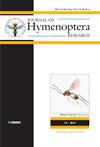海拔梯度影响与网织蜘蛛(蛛形目、网蛛科)相关的异尖蛛(膜翅目、伊蚊科)的分布和寄主利用
IF 1.4
3区 农林科学
Q2 ENTOMOLOGY
引用次数: 1
摘要
寄生蜂的空间分布与其寄主的分布和生态需求密切相关。一些研究已经记录了拟寄生物的动物群组成随海拔的变化,但关于与蜘蛛相关的拟寄生物的数据缺失。在欧洲的蜘蛛属蜘蛛(蜘蛛科)中,有一种叫Zatypota anomala的蜘蛛。研究了中欧森林过渡带中蜘蛛科蜘蛛的分布,海拔梯度为110-1466 m。我们检查了蜘蛛是否被Z. anomaly寄生。在中海拔(平均海拔712 m,海拔范围179 ~ 870 m)最丰富。我们鉴定出四种双翅目蜘蛛是异角蛛的宿主。这些植物分别是黄花丁菊、花丁菊、黄花丁菊和华氏丁菊。所有4种及Nigma属均为首次记录寄主。寄生蜂强烈偏爱寄主的幼虫。被寄生蜘蛛的体长与被寄生蜘蛛不同,中值分别为1.95 mm和2.55 mm。在海拔梯度上,姬蛛和尼格玛蛛的分布重叠,但寄生率在海拔梯度上存在显著差异。寄生在海拔较低的海拔179 ~ 254 m,寄生在海拔较高的海拔361 ~ 870 m。异斑姬蛛的物候特征与其寄主蜘蛛的单一化生活策略密切相关。雌性寄生物在秋季产卵,其后代在寄主上越冬为幼虫,在春季进入成年期,并以成虫的身份度过夏季。本文章由计算机程序翻译,如有差异,请以英文原文为准。
Elevation gradient affects the distribution and host utilisation of Zatypota anomala (Hymenoptera, Ichneumonidae) associated with mesh web weaving spiders (Araneae, Dictynidae)
The spatial distribution of parasitoids is closely linked to the distribution and ecological requirements of their hosts. Several studies have documented changes in the fauna composition of parasitoids in response to elevation, but data on parasitoids associated with spiders are missing. The koinobiont ichneumonid wasp Zatypota anomala is strictly specialised on spiders of the genus Dictyna (Dictynidae) in Europe. We examined the distribution of spiders of the family Dictynidae in forest ecotones in central Europe across a broad elevation gradient (110–1466 m a.s.l.). We checked the spiders for parasitism by Z. anomala. It was most abundant at the mid-elevations (median 712 m a.s.l., range 179–870 m a.s.l.). We identified four dictynid spider species as Z. anomala hosts. These were Dictyna arundinacea, Dictyna uncinata, Nigma flavescens, and Nigma walckenaeri. All four species and the genus Nigma were recorded as hosts for the first time. The parasitoids strongly preferred juvenile instars of their hosts. The body length differed between parasitised Dictyna and Nigma spiders (medians: 1.95 mm and 2.55 mm, respectively). The distribution of Dictyna and Nigma spiders overlapped along the elevation gradient, but parasitism incidence significantly differed between spider genera along the elevation gradient. Nigma was parasitized at lower elevations between 179–254 m a.s.l. and Dictyna at higher elevations between 361–870 m a.s.l. The phenology of Z. anomala is closely tied to the univoltine life strategy of its host spiders. The parasitoid female oviposits in autumn, and its offspring overwinter as larvae on the host, reach adulthood during spring, and pass the summer as an adult.
求助全文
通过发布文献求助,成功后即可免费获取论文全文。
去求助
来源期刊
CiteScore
2.60
自引率
15.40%
发文量
68
审稿时长
>12 weeks
期刊介绍:
The Journal of Hymenoptera Research is a peer-reviewed, open-access, rapid online journal launched to accelerate research on all aspects of Hymenoptera, including biology, behavior, ecology, systematics, taxonomy, genetics, and morphology.
All published papers can be freely copied, downloaded, printed and distributed at no charge for the reader. Authors are thus encouraged to post the pdf files of published papers on their homepages or elsewhere to expedite distribution. There is no charge for color.

 求助内容:
求助内容: 应助结果提醒方式:
应助结果提醒方式:


